Detailed Simulation of the Nominal Flow and Temperature Conditions in a Pre-Konvoi PWR Using Coupled CFD and Neutron Kinetics
Abstract
1. Introduction
2. Geometry of the CFD Model
3. Technological Boundary Conditions
- –
- Typical EOC power distribution in the core (calculation with DYN3D for a generic Pre-Konvoi core loading pattern, off-line coupling with CFD);
- –
- Mass flow rate per loop 4910.5 (kg/s);
- –
- Temperature at the RPV inlet: 293.8 °C;
- –
- RPV internal pressure: 157 bar (Reactor Inlet).
4. Physical and Numerical Model Properties
- –
- Adiabatic walls with standard logarithmic wall function;
- –
- Pressure boundary condition at the hot main coolant pipe legs;
- –
- Incompressible coolant;
- –
- Transient CFD calculation with initially quiescent coolant;
- –
- Second order spatial and temporal discretization scheme;
- –
- Turbulence model: stress blended eddy simulation (SBES)
5. Porous Body Modeling of the Core
6. Power Distribution within the Core
- -
- Thermal power: 3950 MW;
- -
- Boron concentration: 50 ppm;
- -
- Temperature at the core inlet: 293.8 °C;
- -
- Core mass flow: 19,642 kg/s.
7. Results
8. Securing the Results with the Wanninger Model Approach [11]
9. Conclusions
Author Contributions
Funding
Conflicts of Interest
References
- Prasser, H.-M.; Kliem, S. Coolant mixing experiments in the upper plenum of the ROCOM test facility. Nucl. Eng. Des. 2014, 276, 30–42. [Google Scholar] [CrossRef]
- Kliem, S.; Gommlich, A.; Grahn, A.; Rohde, U.; Schuetze, J.; Frank, T.; Gomez, A.; Sanchez, V. Development of multi-physics code systems based on the reactor dynamics code DYN3D. Kerntechnik 2011, 76, 160–165. [Google Scholar] [CrossRef]
- ANSYS CFX Solver Manual; CFX-18; ANSYS: Canonsburg, PA, USA, 2018.
- Mahaffy, J.; Chung, B.; Song, C.; Dubois, F.; Graffard, E.; Ducros, F.; Heitsch, M.; Scheuerer, M.; Henriksson, M.; Komen, E.; et al. Best Practice Guidelines for the Use of CFD in Nuclear Reactor Safety Applications-Revision; NEA/CSNI/R(2014)11; Organisation for Economic Co-Operation and Development: Paris, France, 2015. [Google Scholar]
- Menter, F. Stress-Blended Eddy Simulation (SBES)—A New Paradigm in Hybrid RANS-LES Modeling. In Proceedings of the Sixth HRLM Symposium, Strasbourg University, Strasbourg, France, 26–28 September 2016; Available online: https://hrlm6.sciencesconf.org/118745/document (accessed on 21 September 2020).
- Cartland Glover, G.; Höhne, T.; Kliem, S.; Rohde, U.; Weiss, F.-P.; Prasser, H.-M. Hydrodynamic phenomena in the downcomer during flow rate transients in the primary circuit of a PWR. Nucl. Eng. Des. 2007, 237, 732–748. [Google Scholar] [CrossRef]
- Höhne, T.; Kliem, S.; Bieder, U. IAEA CRP benchmark of ROCOM PTS test case for the use of CFD in reactor design using the CFD Codes ANSYS CFX and TrioCFD. Nucl. Eng. Des. 2018, 333, 161–180. [Google Scholar] [CrossRef]
- Huang, M.; Höhne, T. Numerical simulation of multicomponent flows with the presence of density gradients for the upgrading of advanced turbulence models. Nucl. Eng. Des. 2019, 344, 28–37. [Google Scholar] [CrossRef]
- Rohde, U.; Kliem, S.; Grundmann, U.; Baier, S.; Bilodid, Y.; Duerigen, S.; Fridman, E.; Gommlich, A.; Grahn, A.; Holt, L.; et al. The reactor dynamics code DYN3D—models, validation and applications. Prog. Nucl. Energy 2016, 89, 170–190. [Google Scholar] [CrossRef]
- Kliem, S.; Rohde, U.; Weiss, F.-P. Core response of a PWR to a slug of under-borated water. Nucl. Eng. Des. 2004, 230, 121–132. [Google Scholar] [CrossRef]
- Wanninger, A.; Seidl, M.; Macián-Juan, R. Mechanical analysis of the bow deformation of a row of fuel assemblies in a PWR core. Nuclear Eng. Technol. 2018, 50, 297–305. [Google Scholar] [CrossRef]
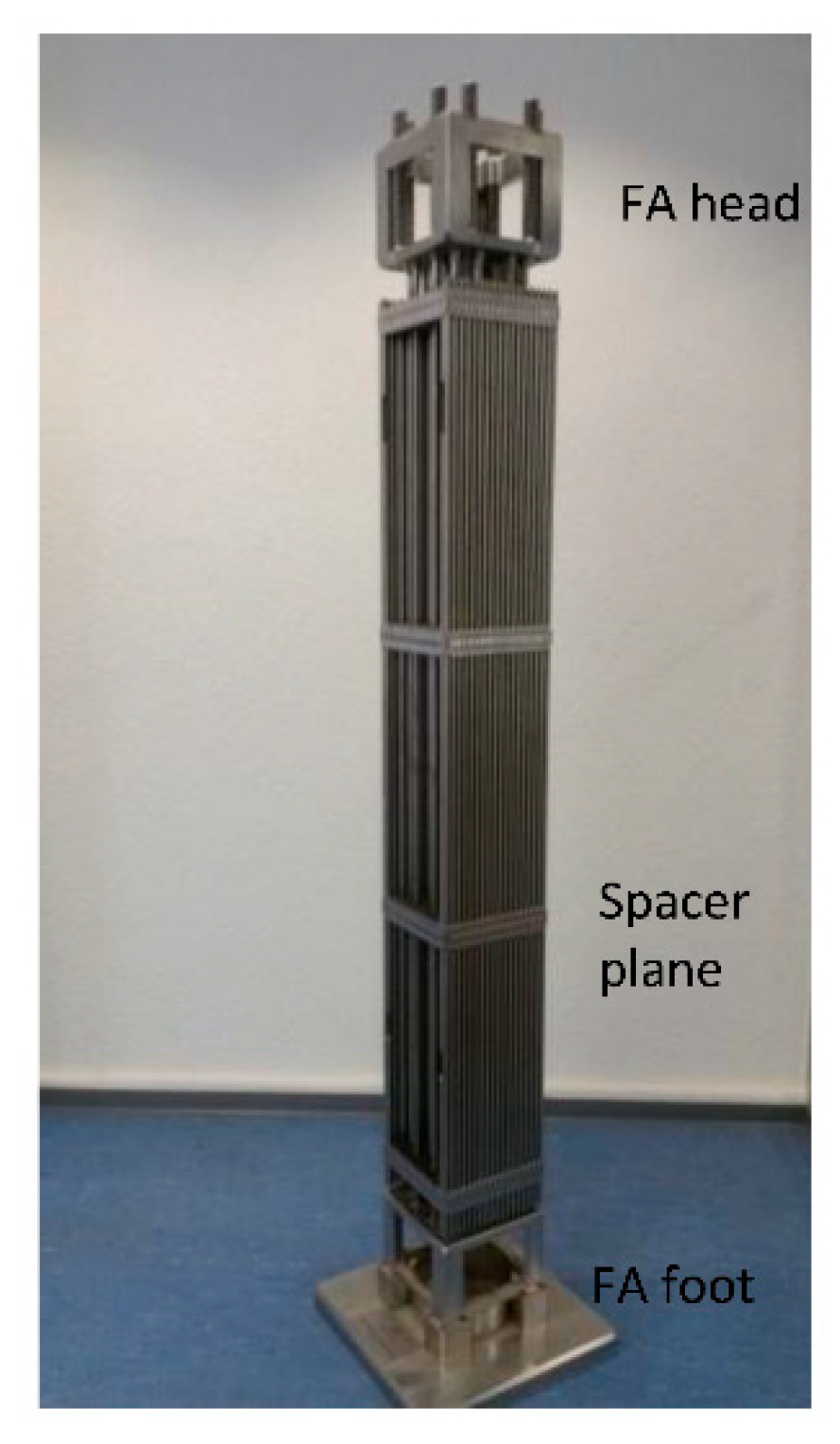


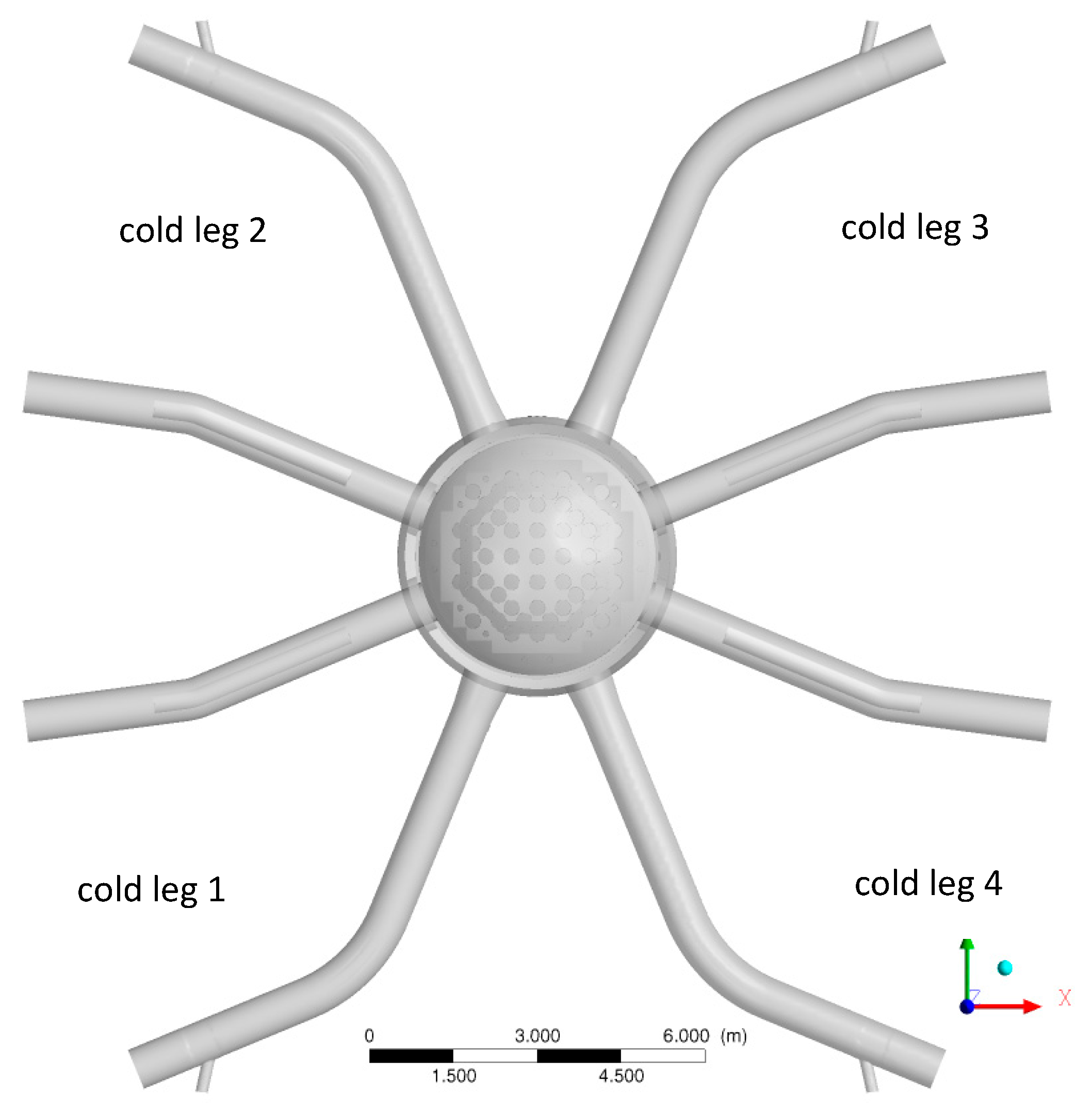
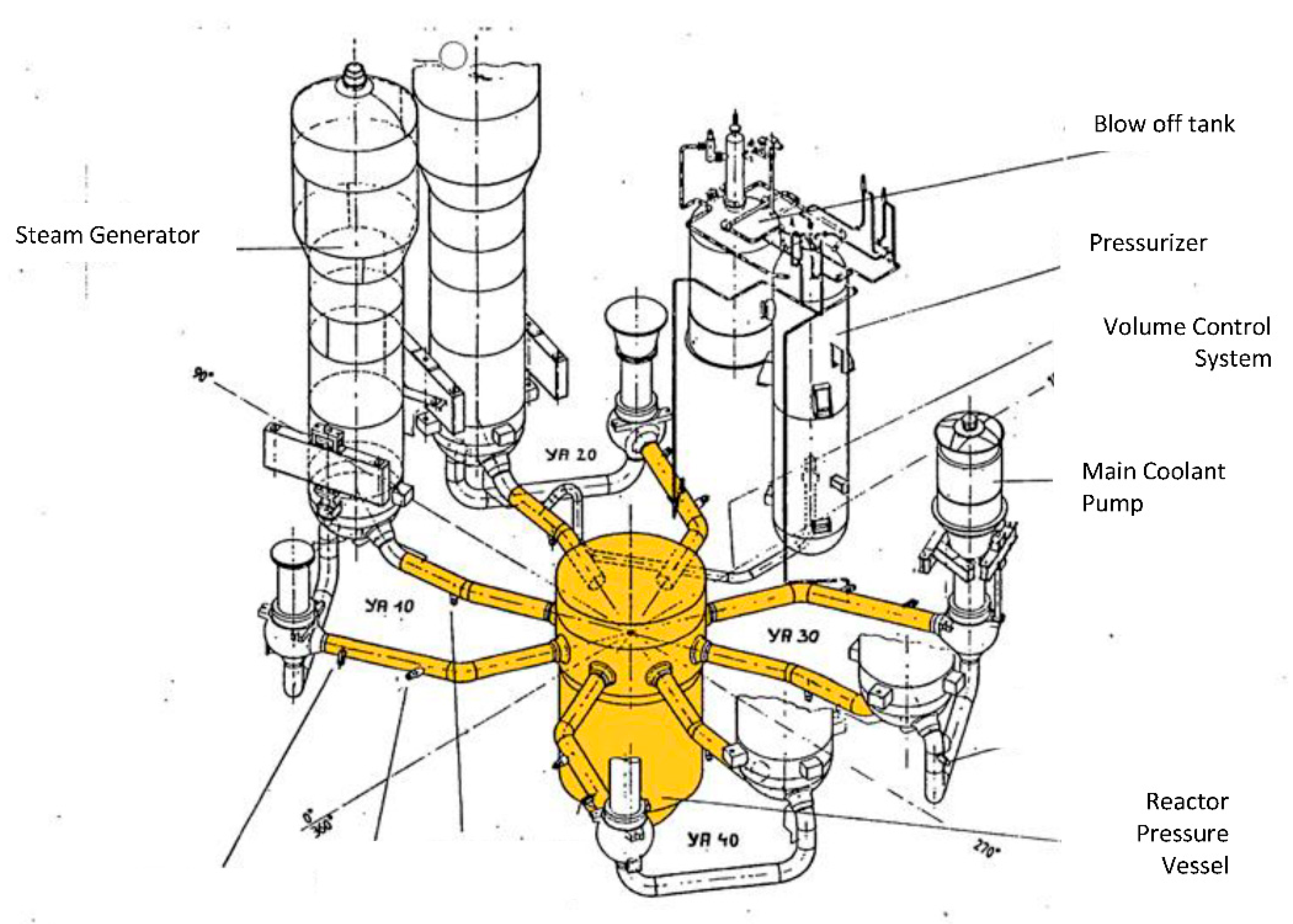
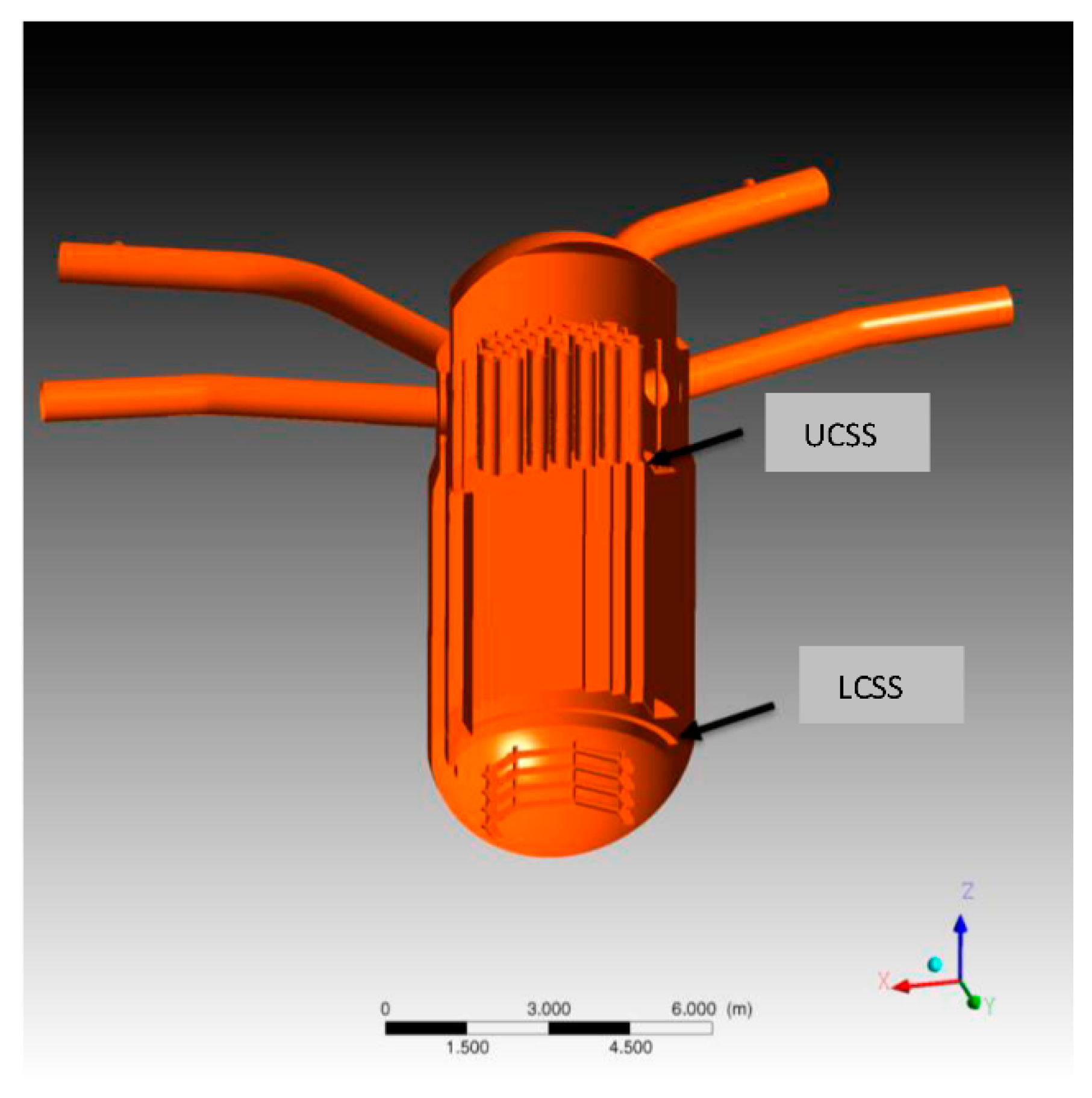
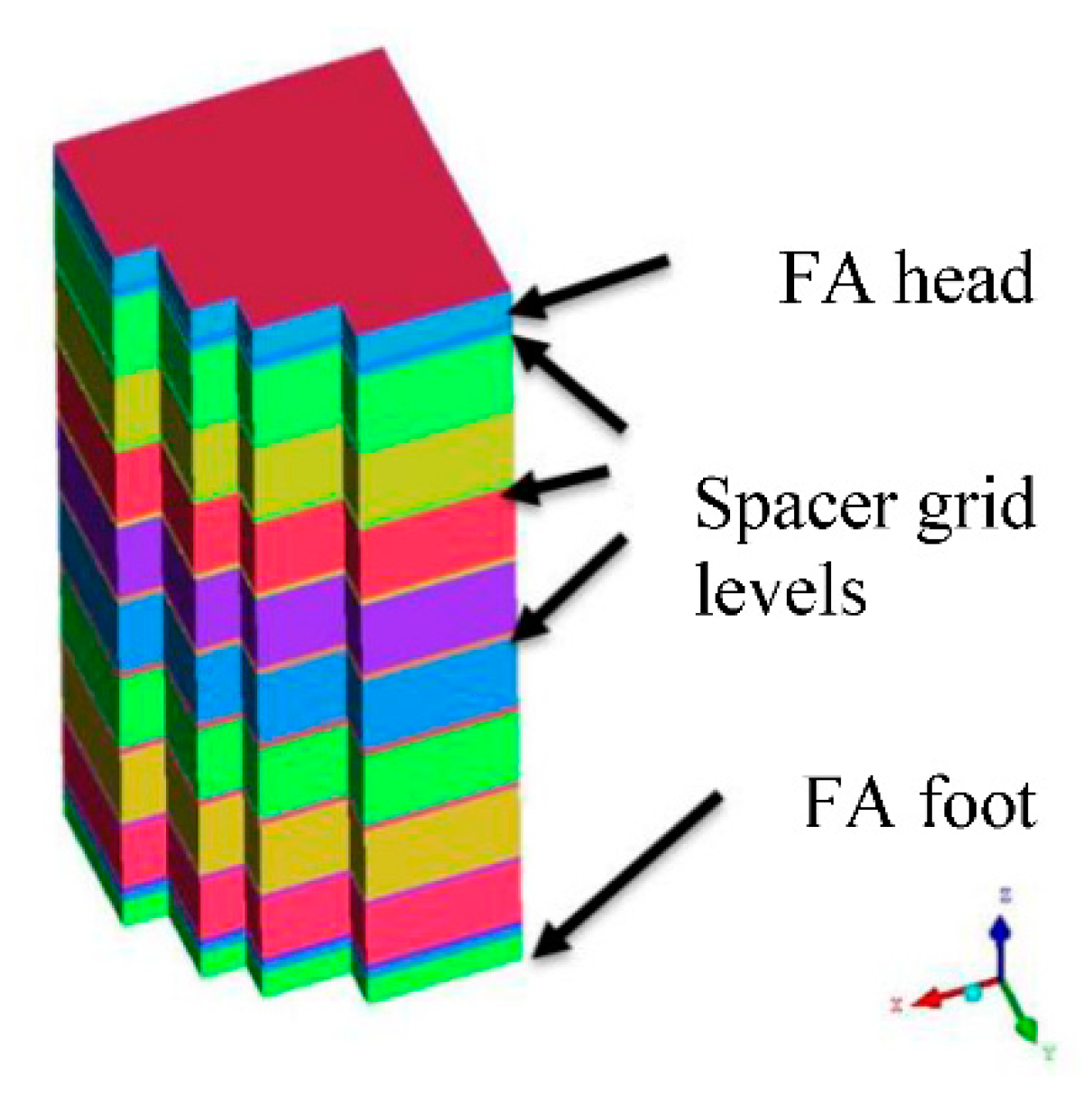
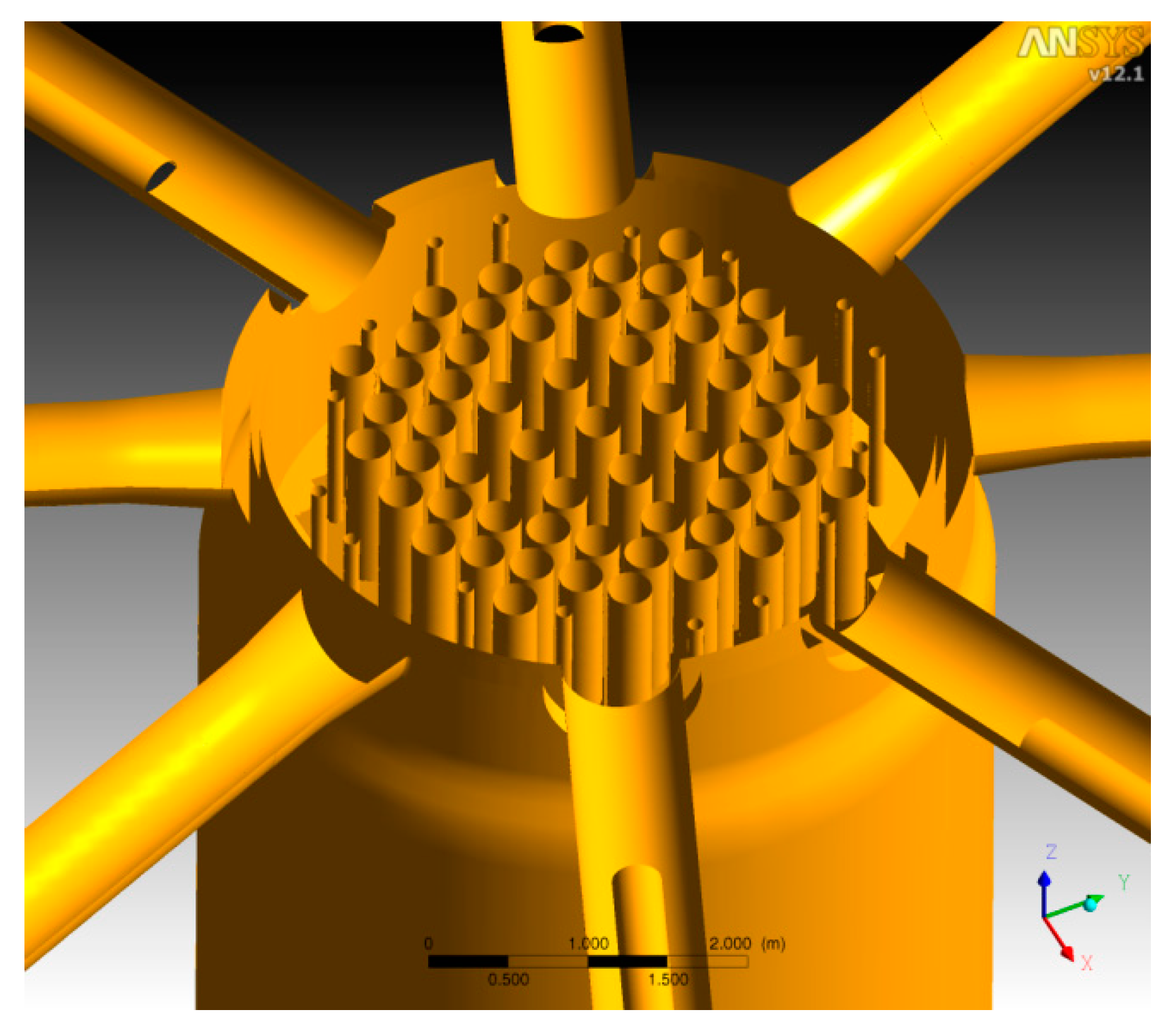
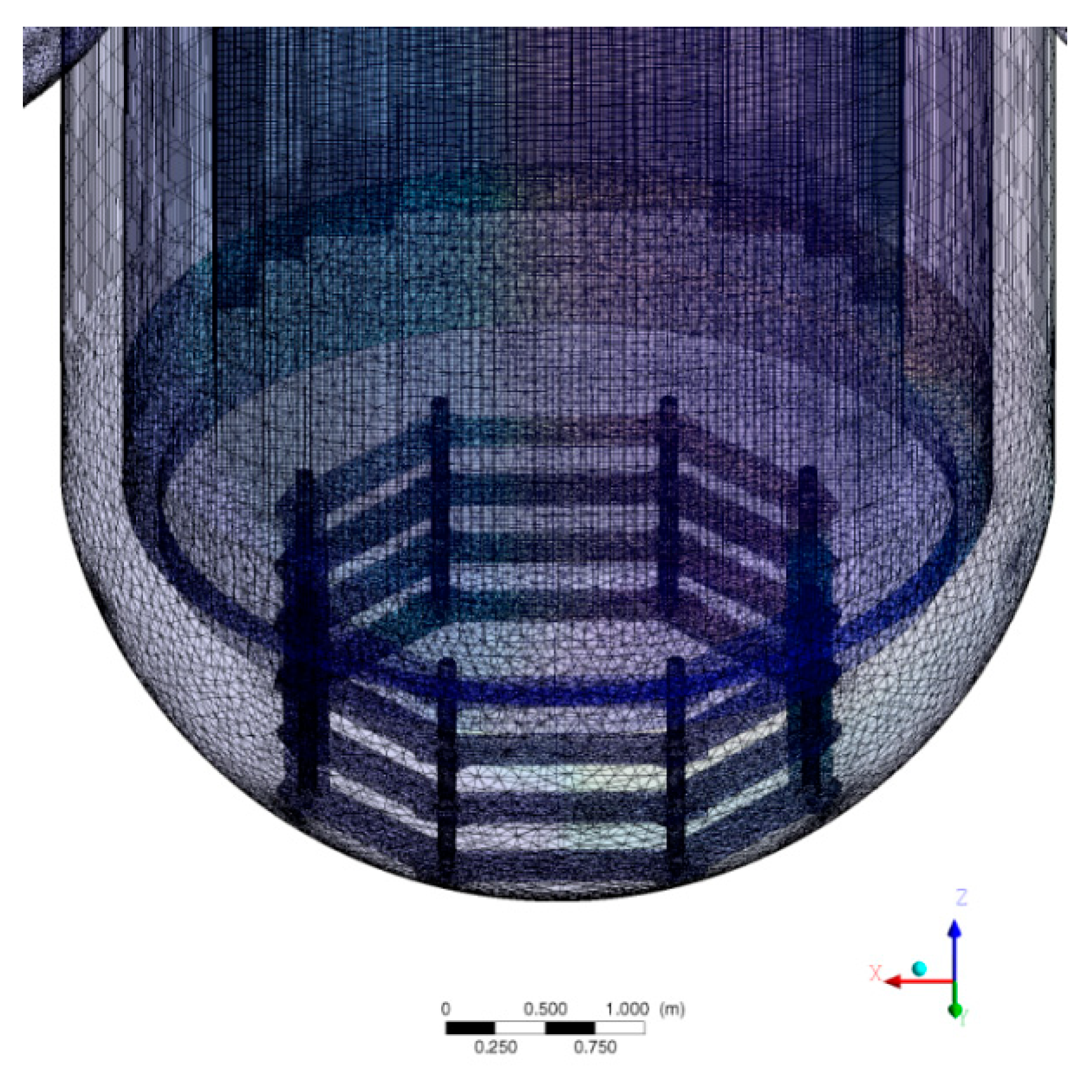
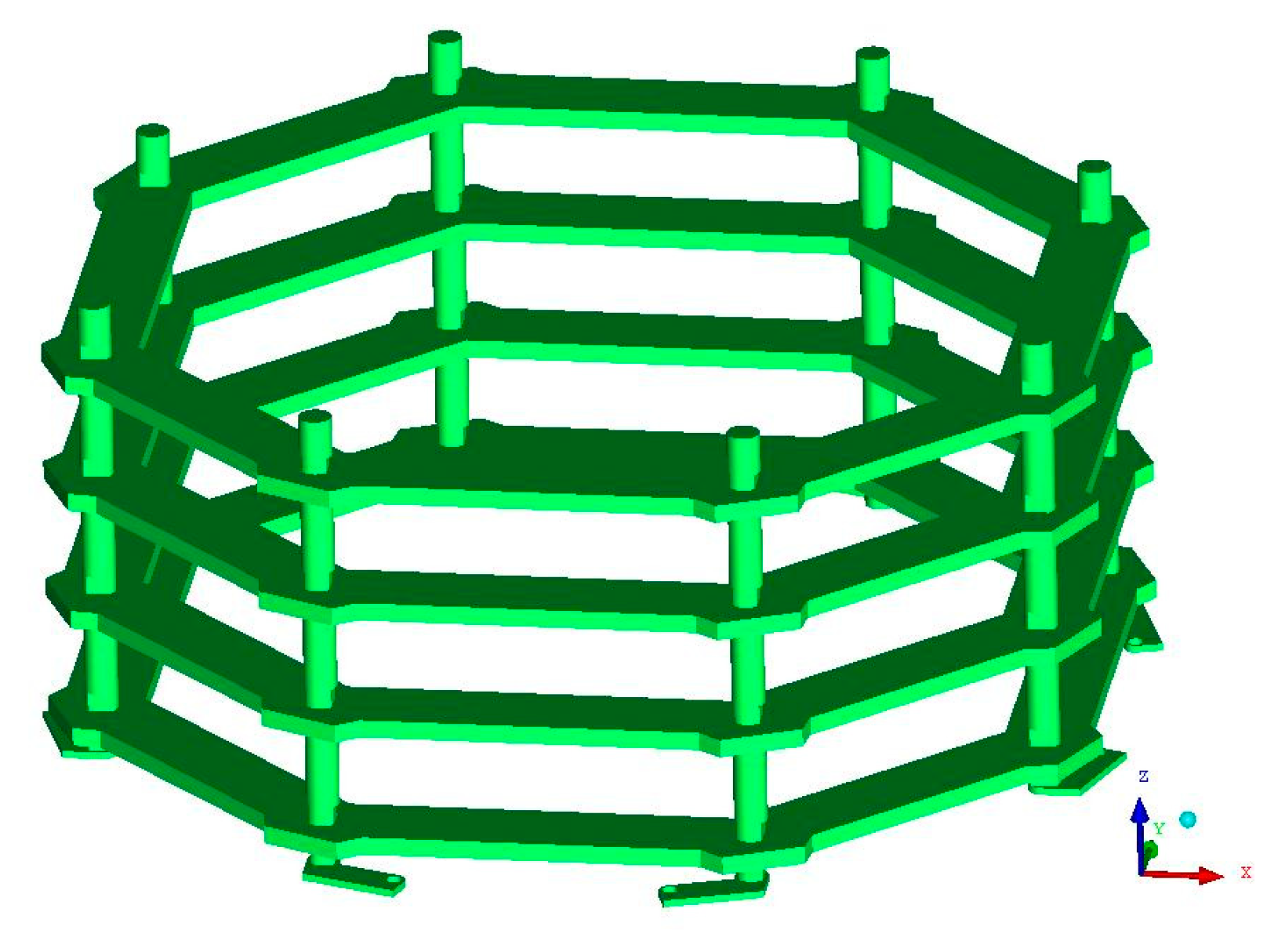

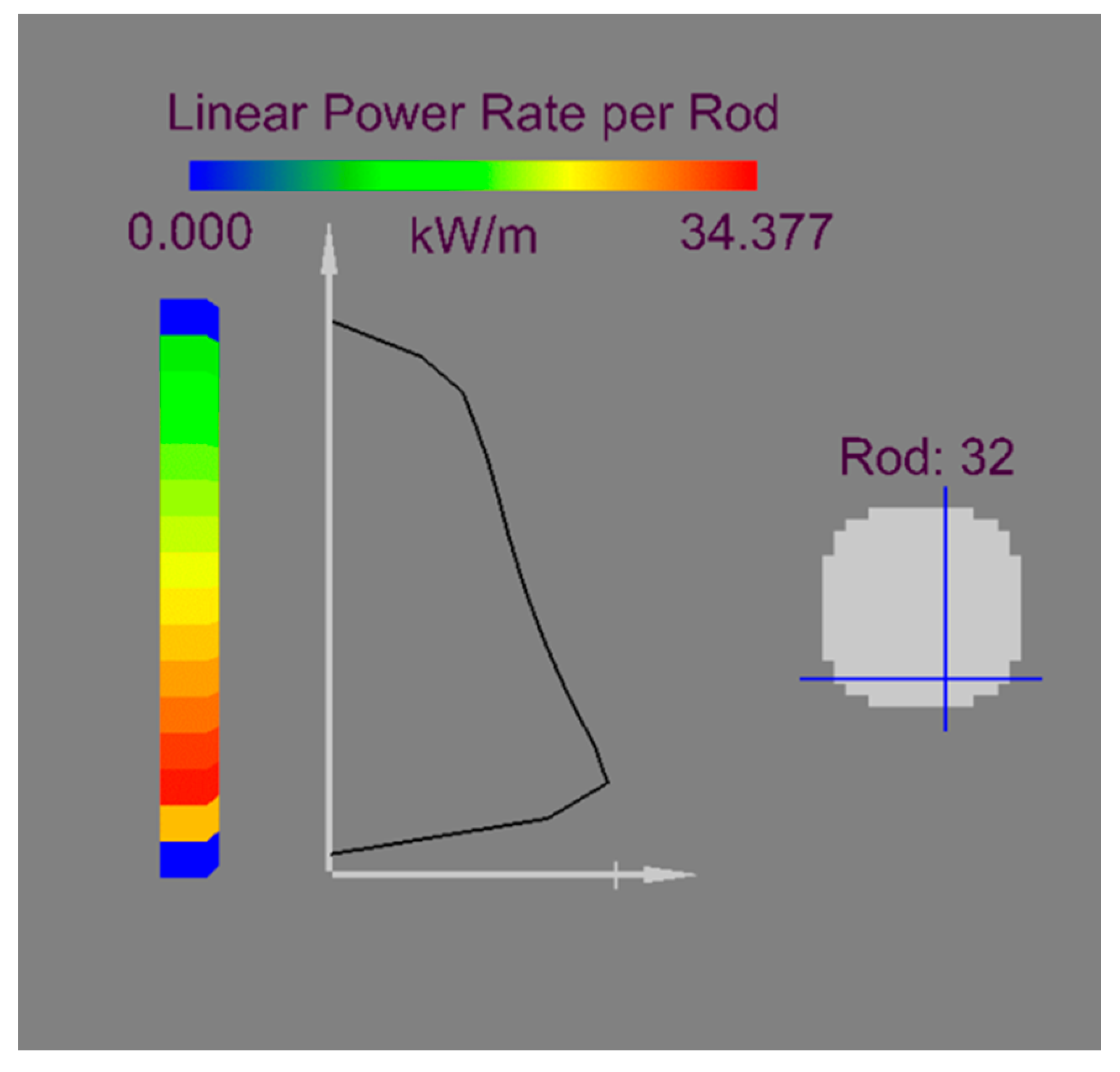
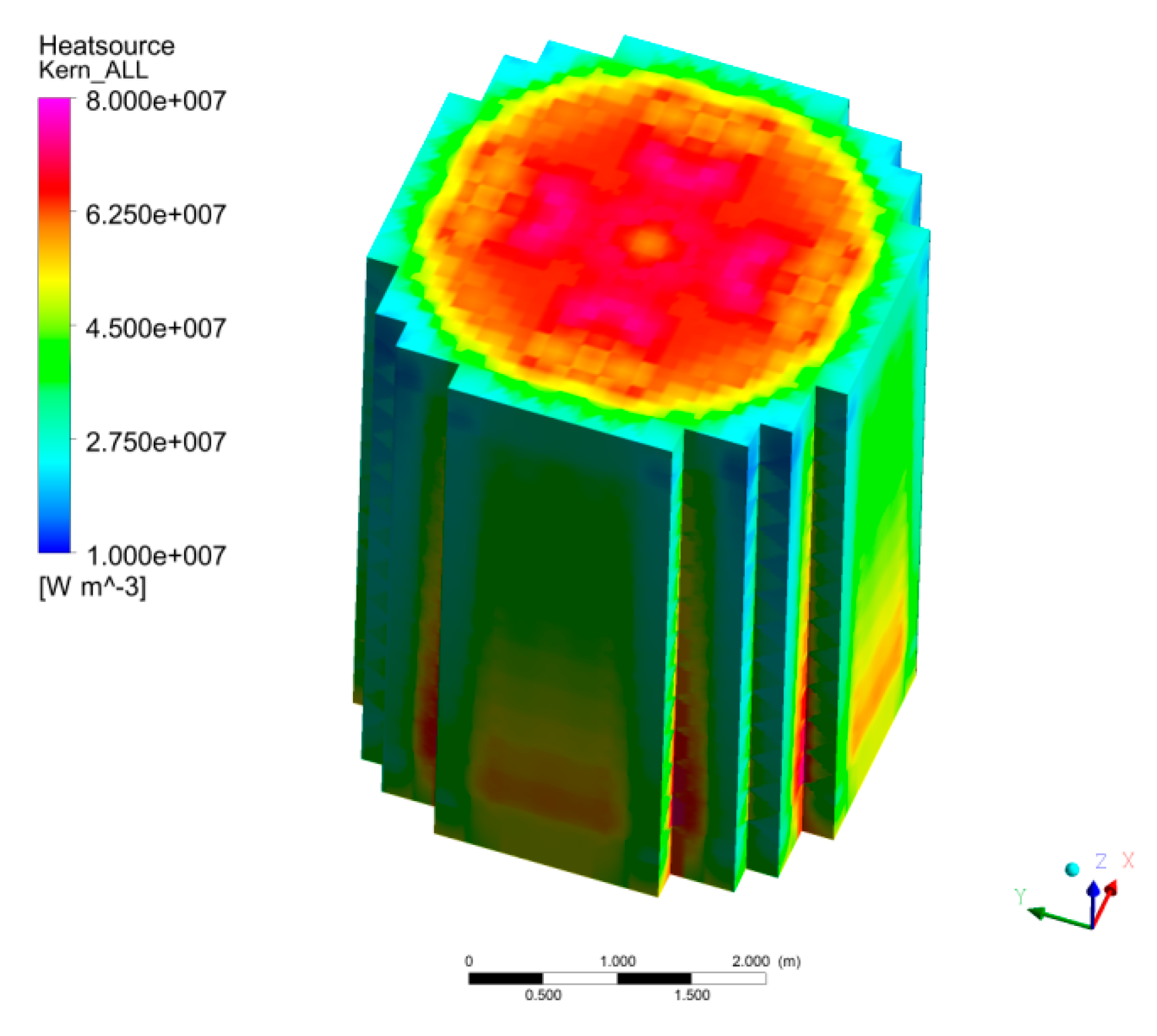
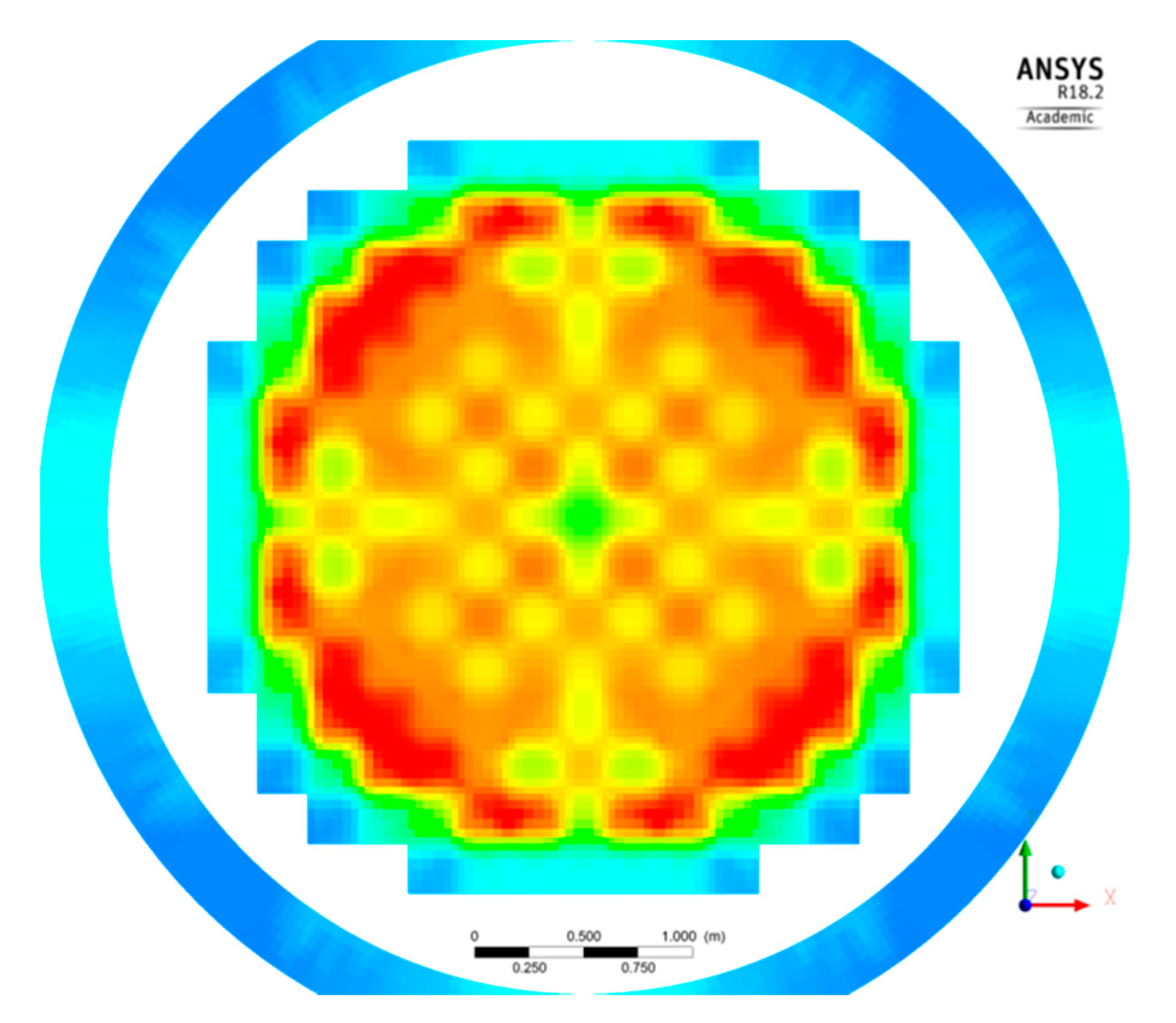

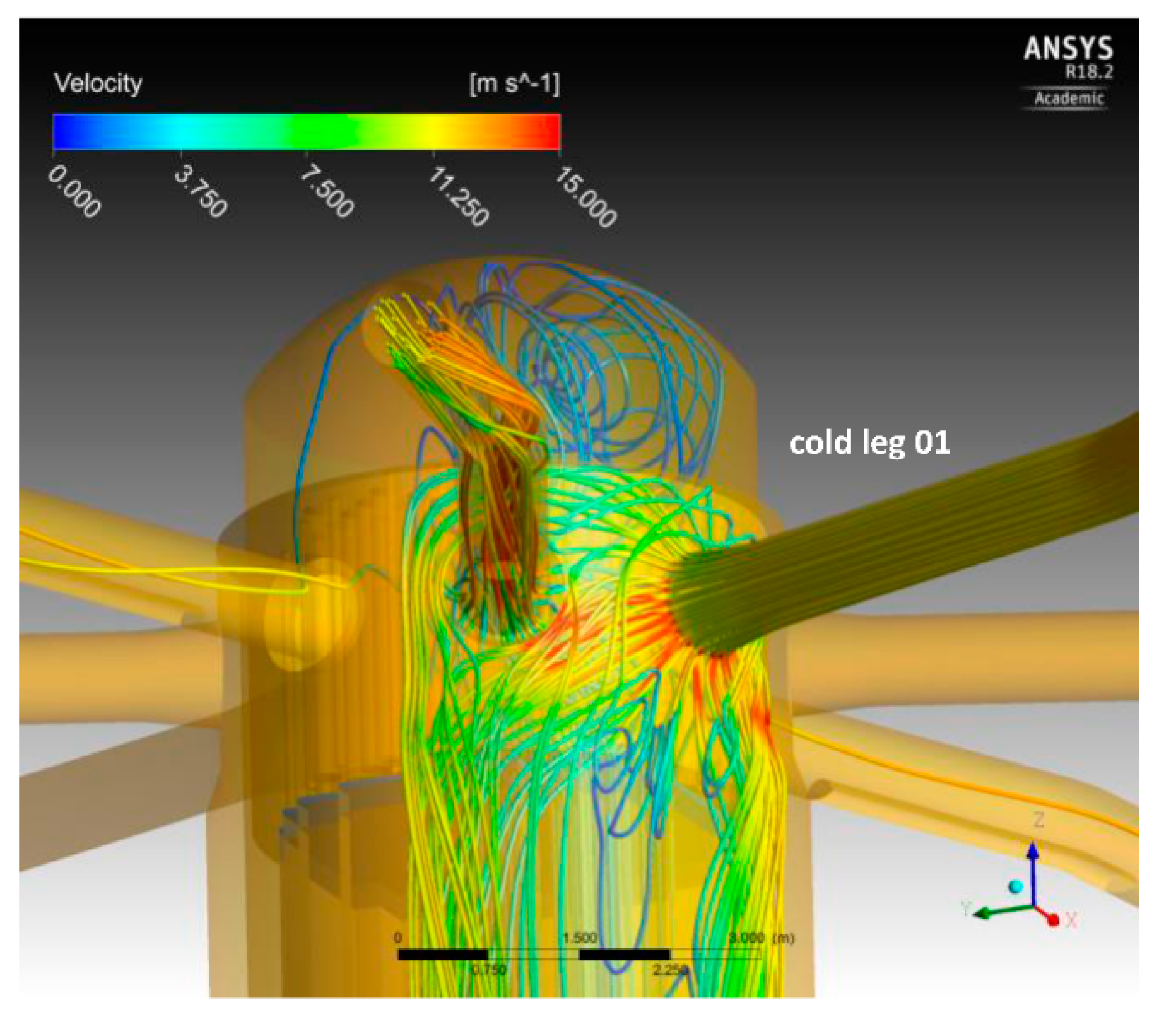

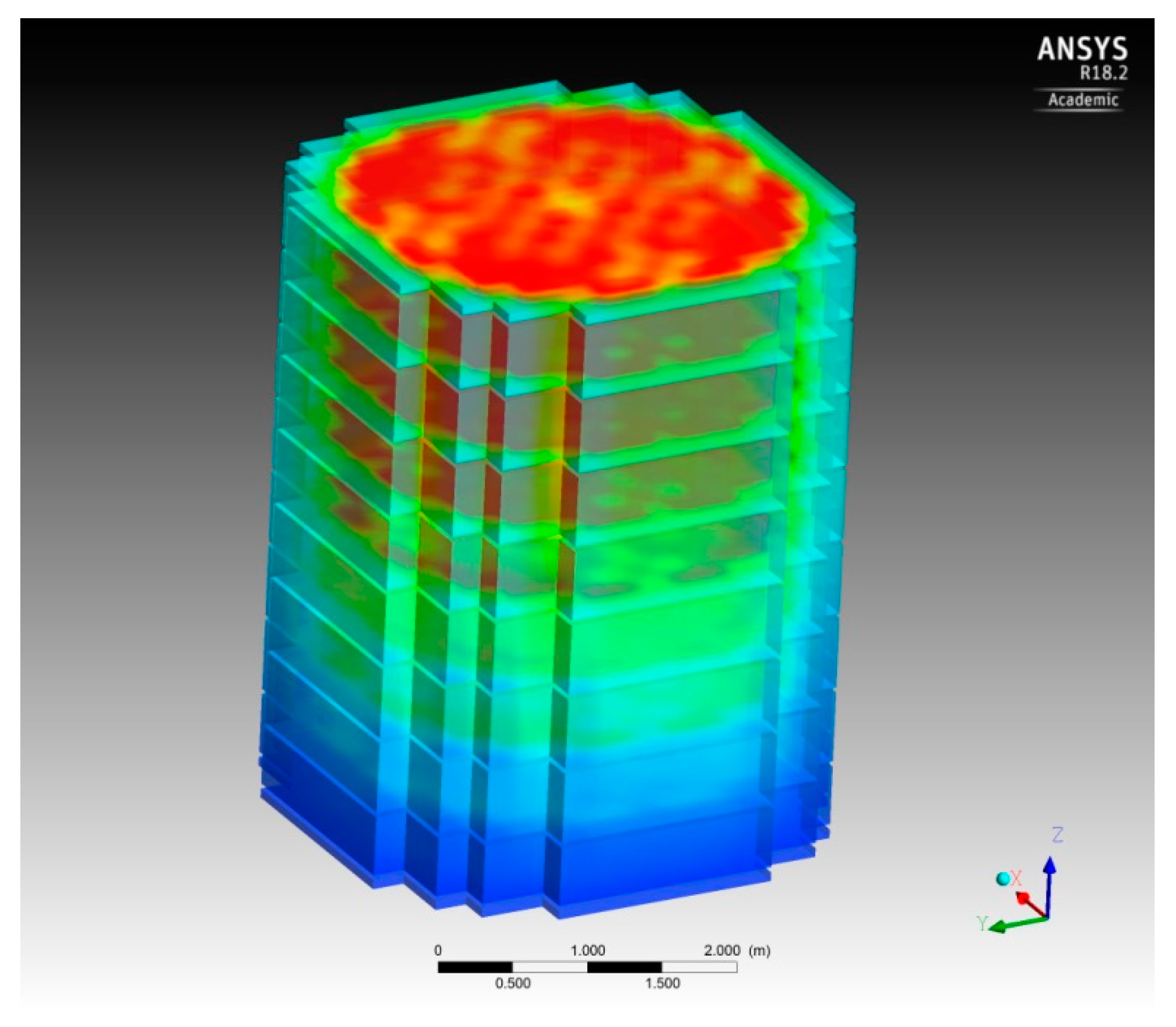



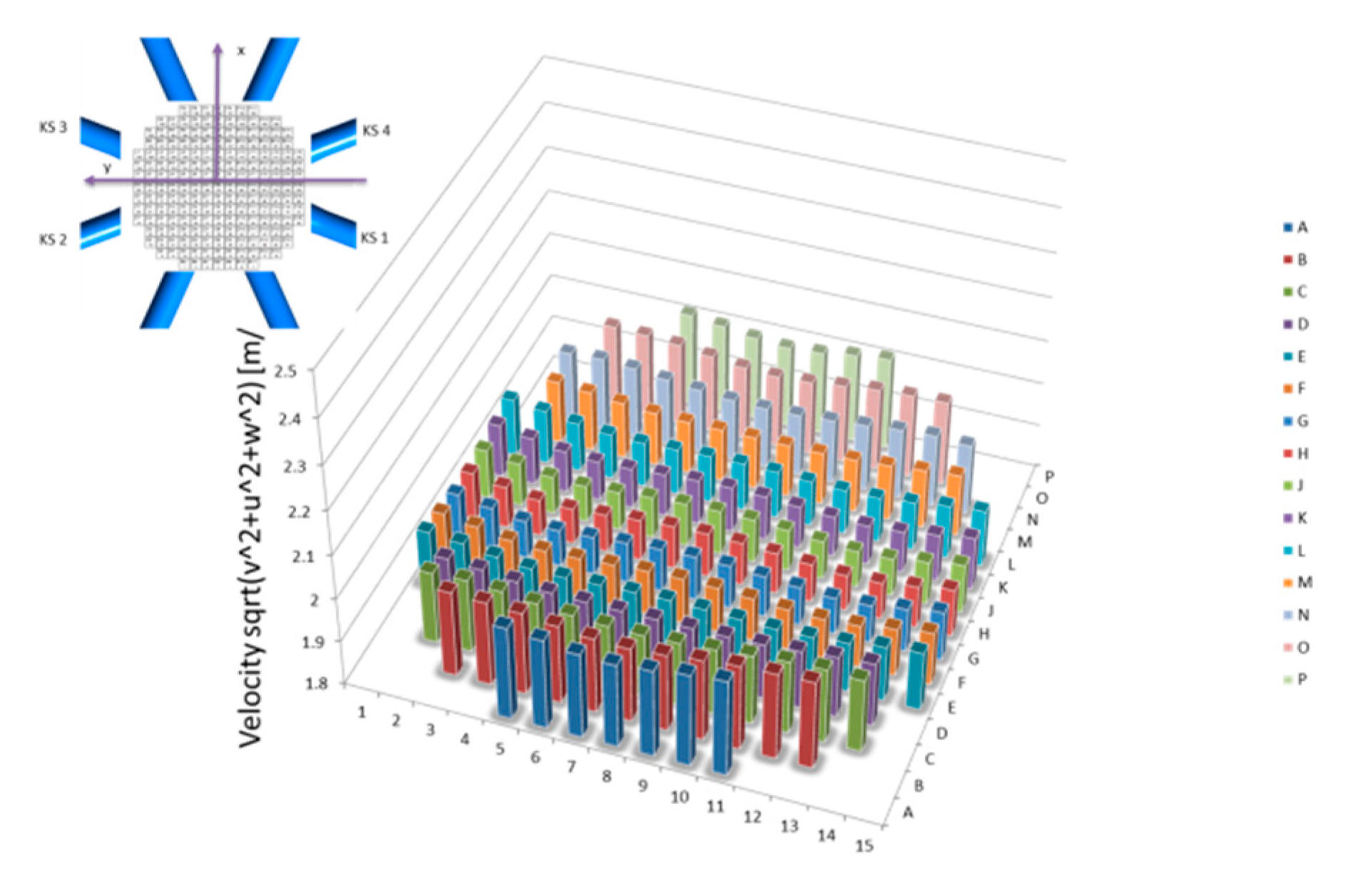

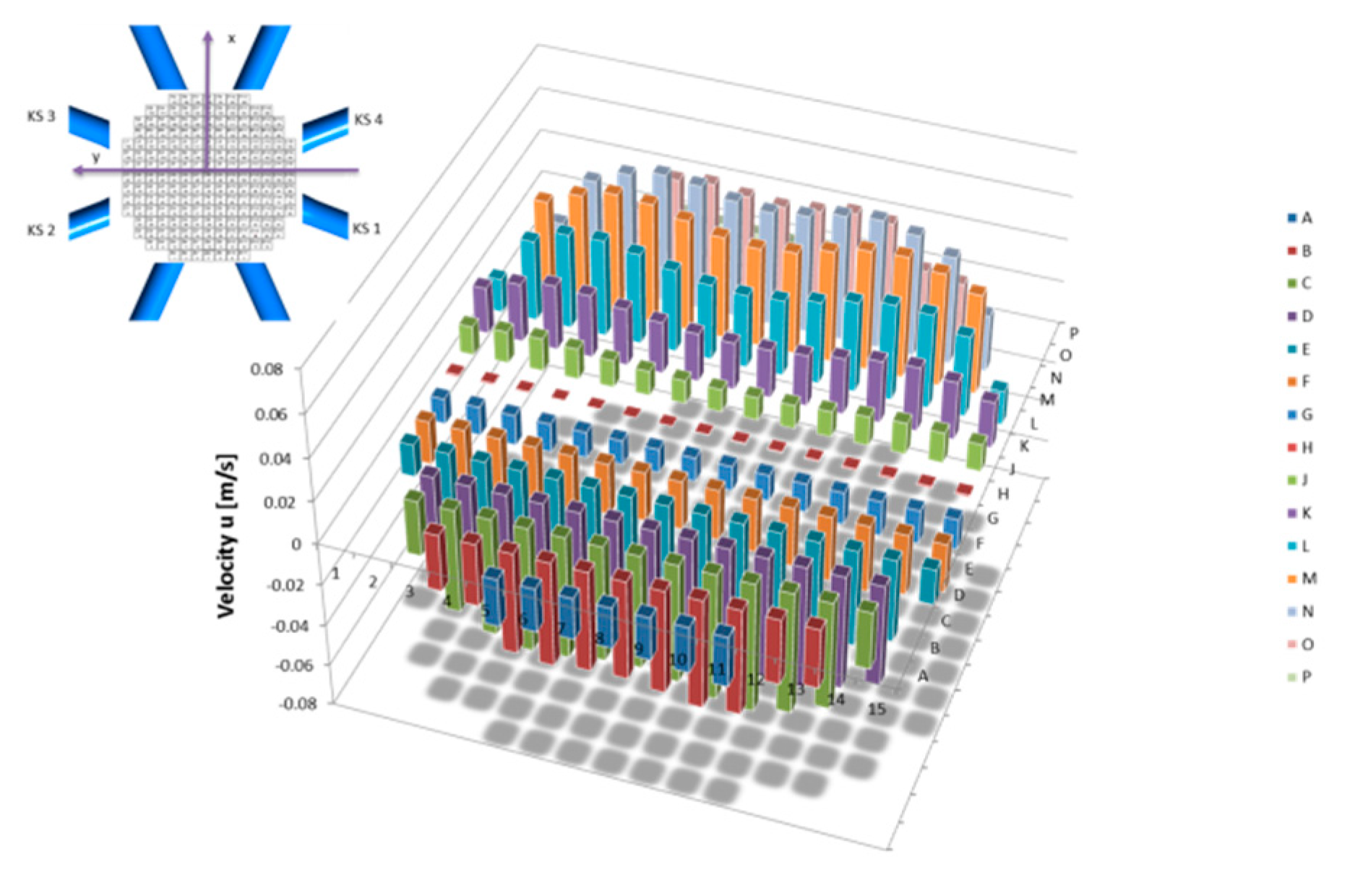
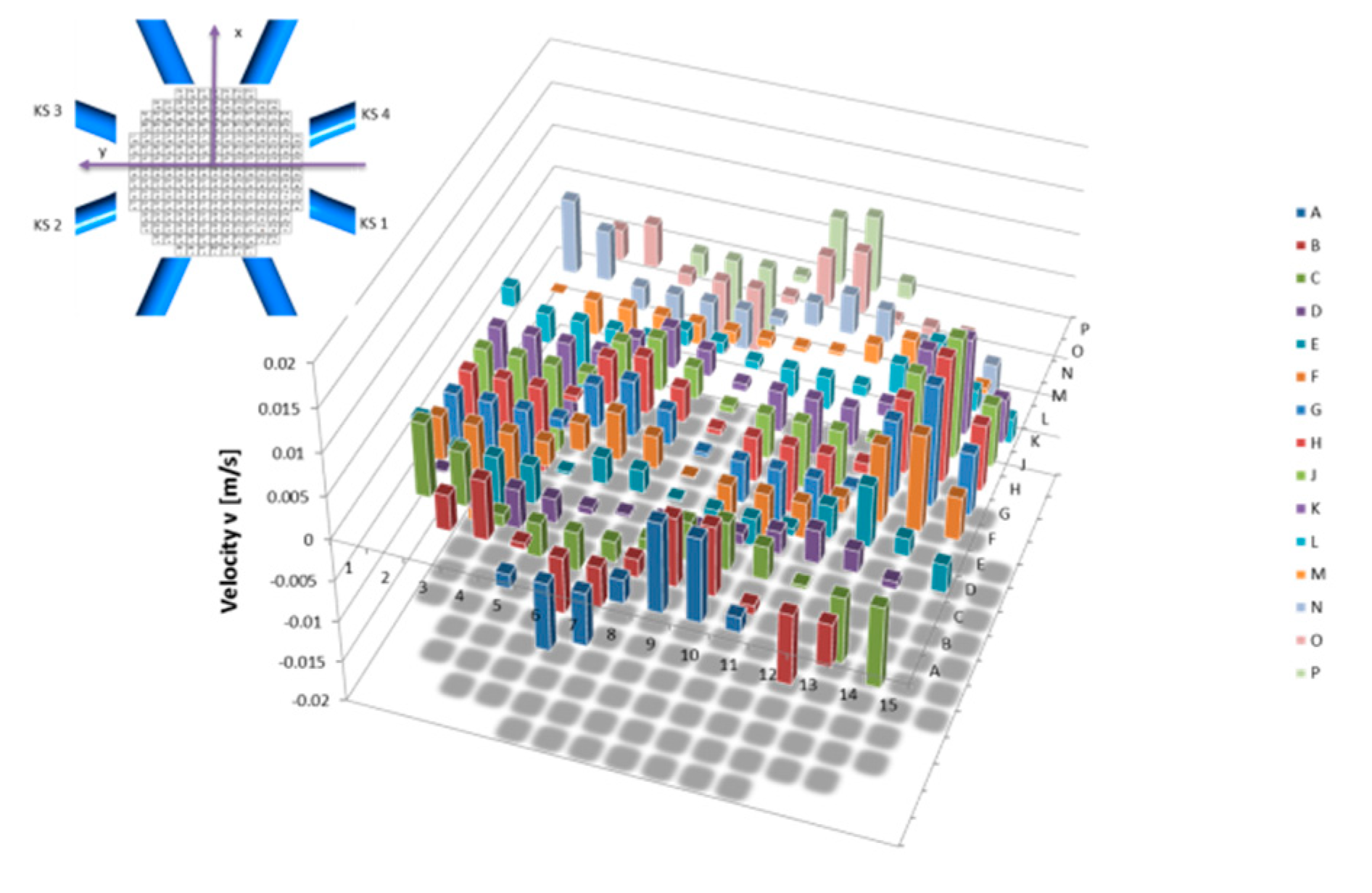
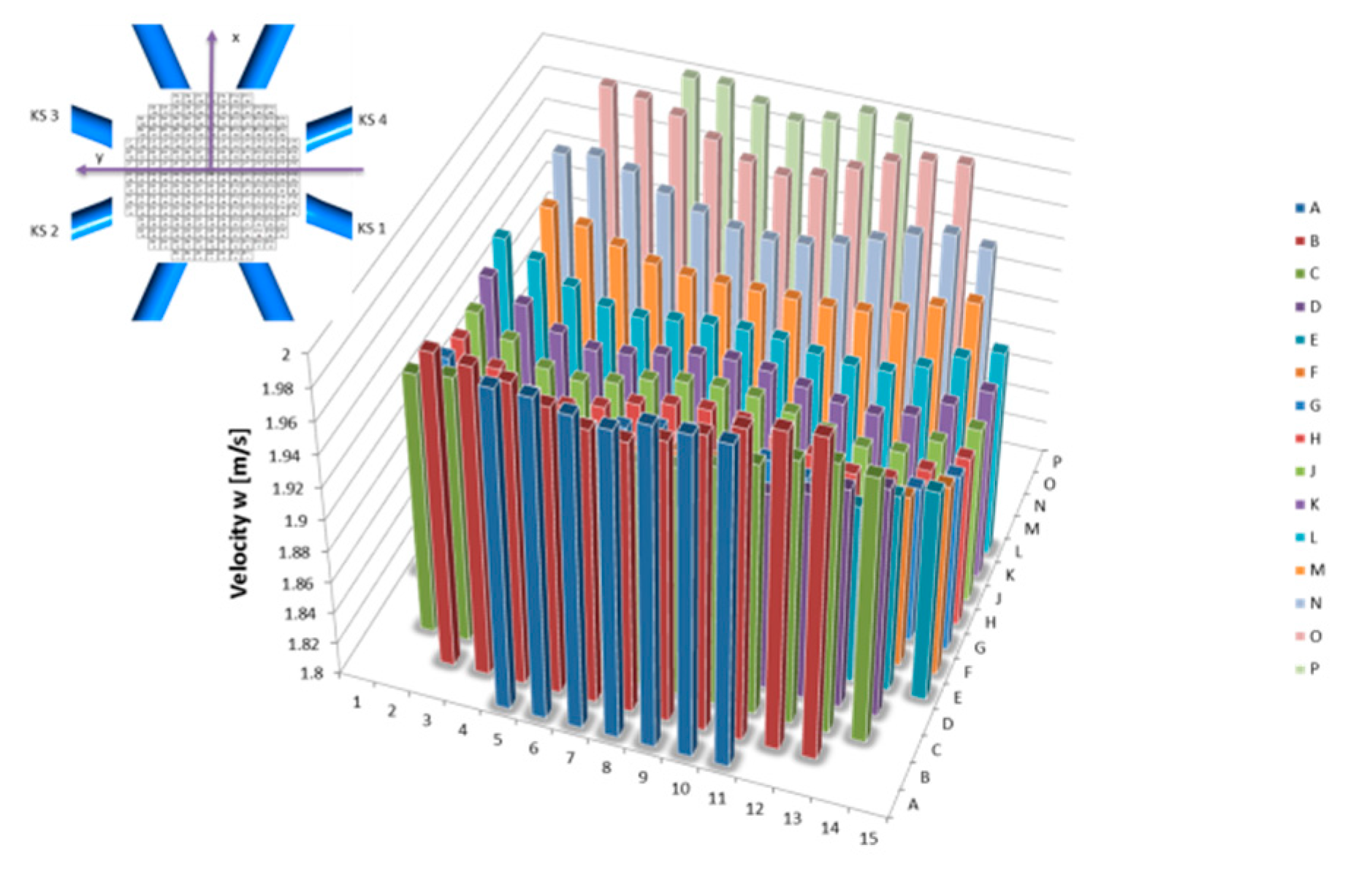

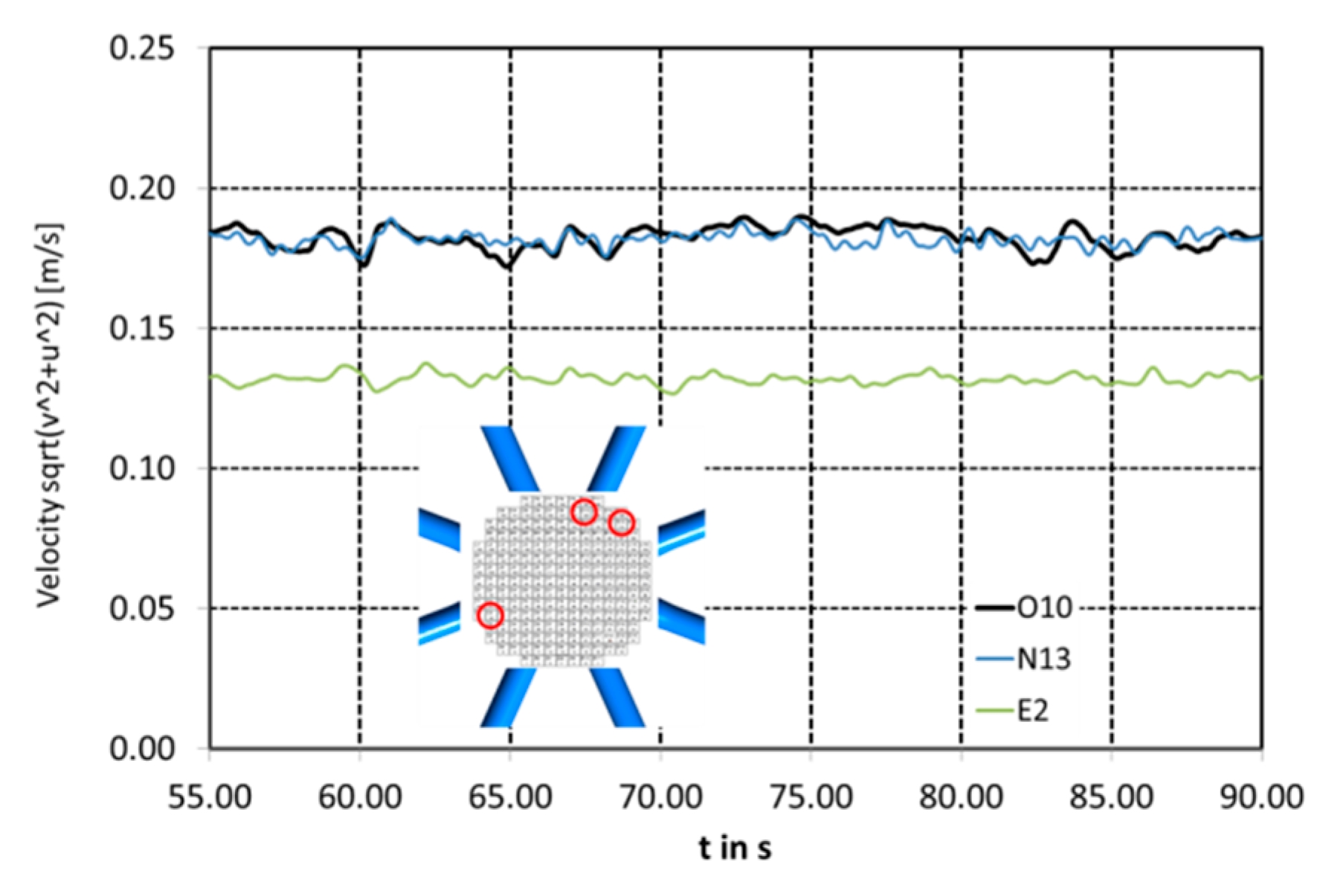
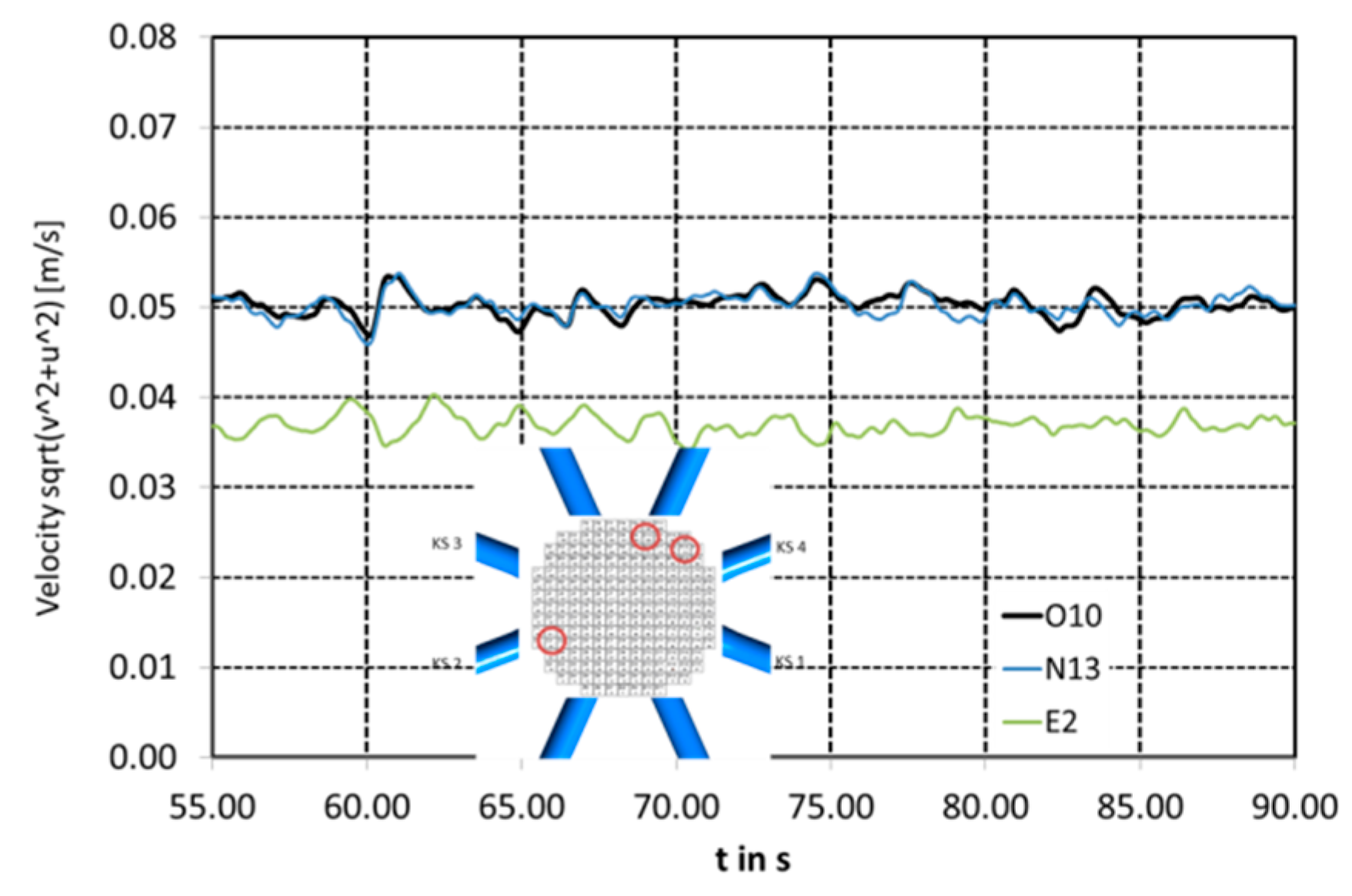
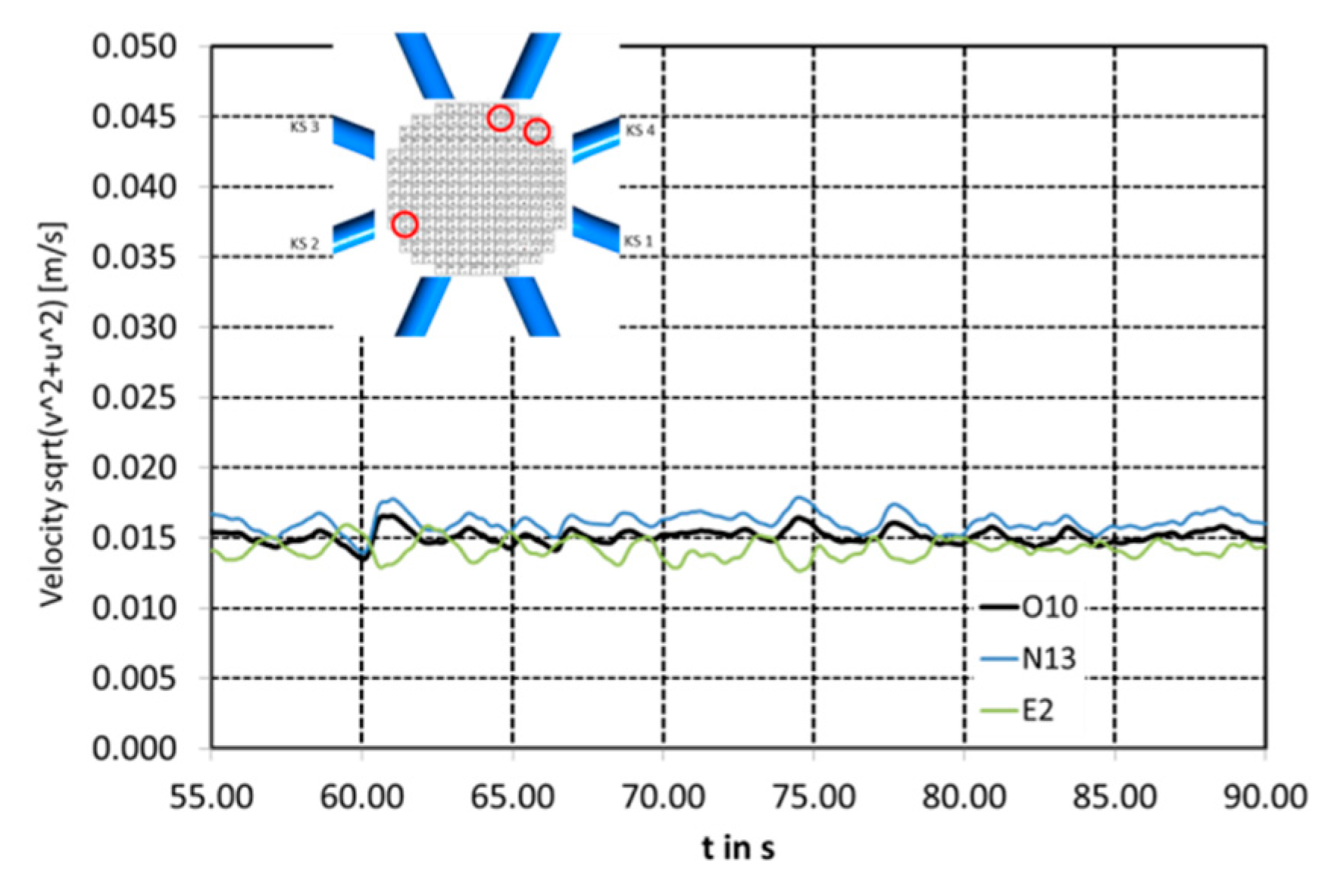

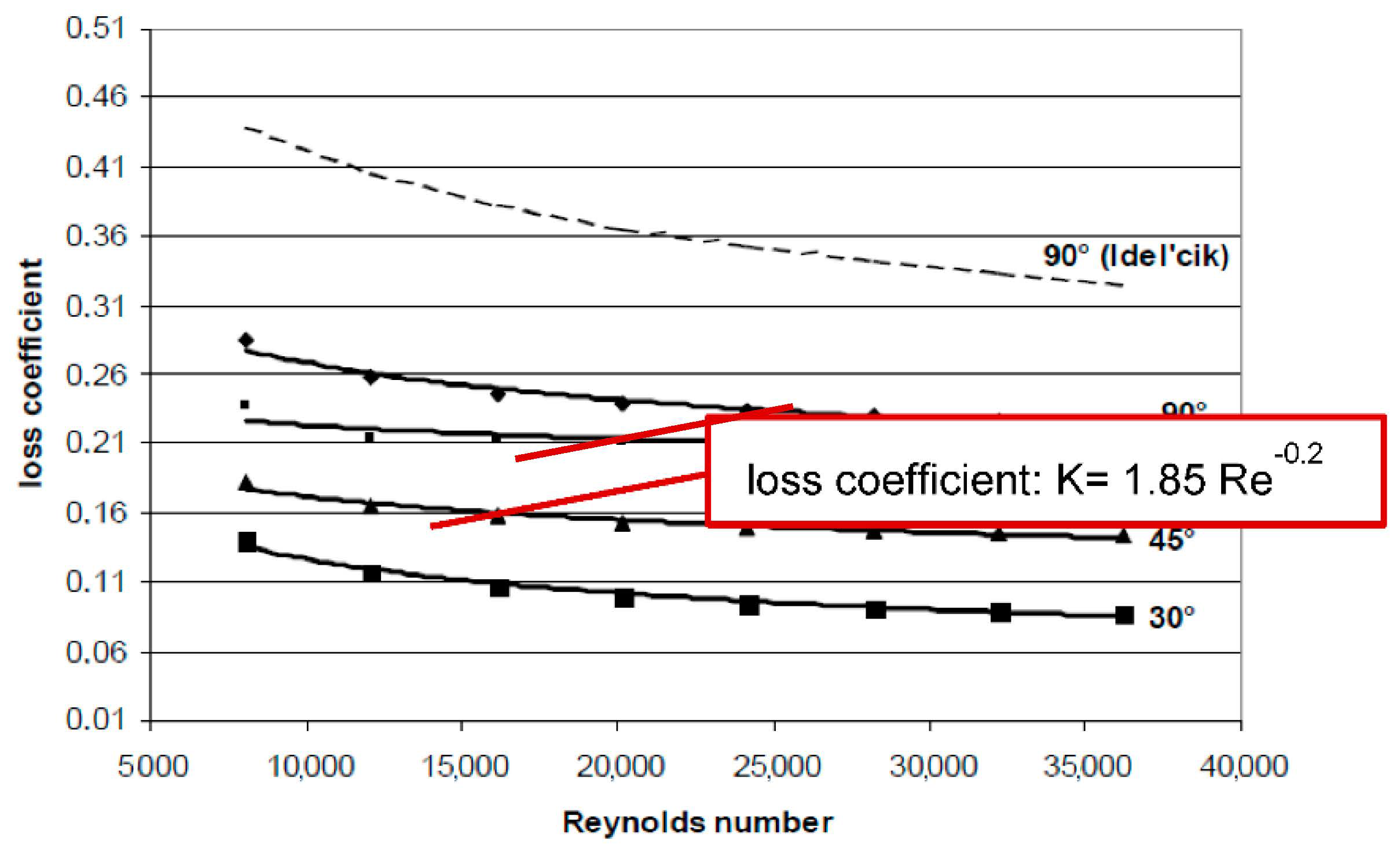



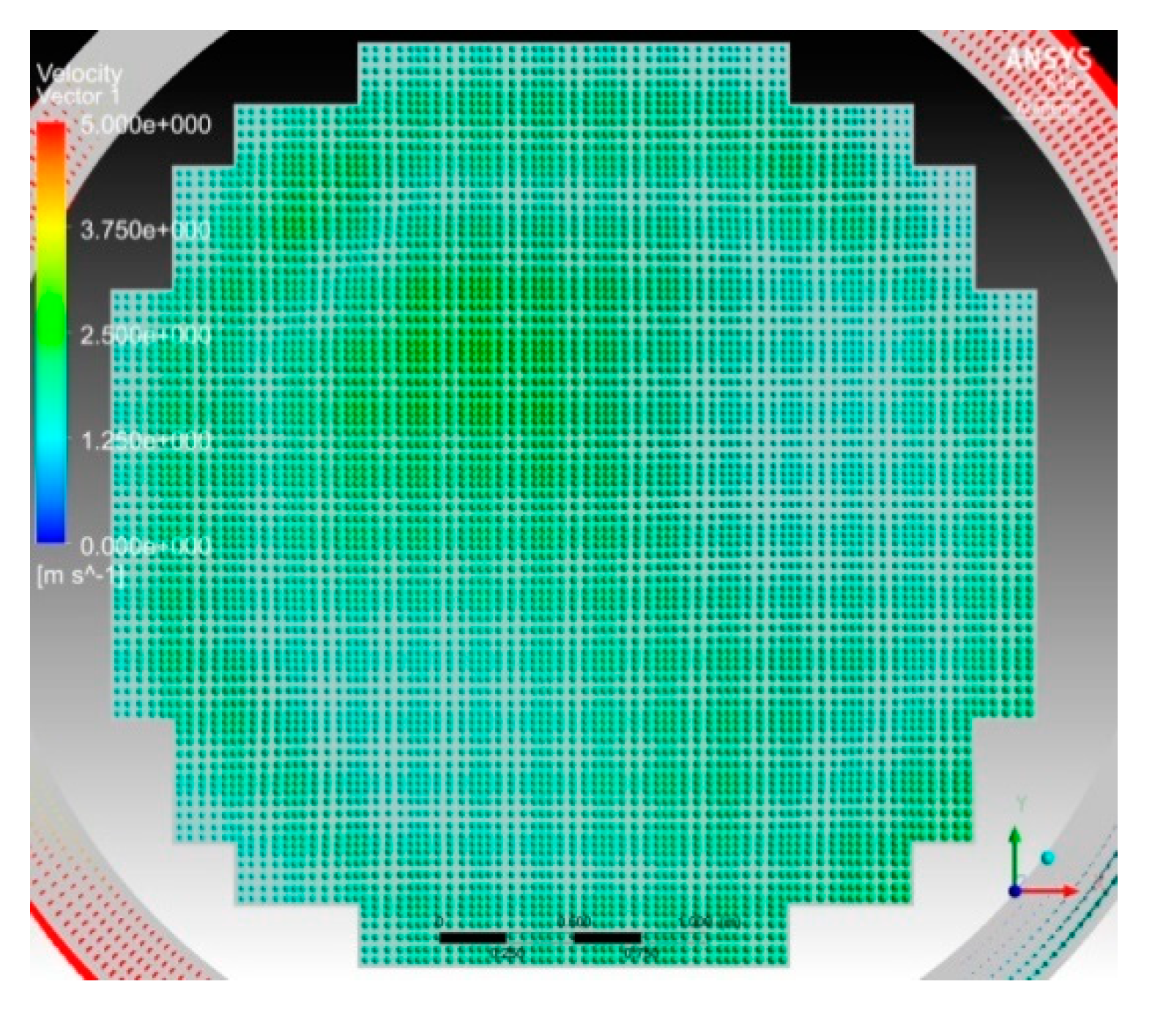
| ∆p (bar) | |
|---|---|
| FA foot | 0.1319 |
| Sum over SG zones: | 0.7109 |
| Sum over open FA area: | 0.4225 |
| FA head | 0.1052 |
| Total: | 1.37 |
| LCSS | 0.007 |
| UCSS | 0.0744 |
© 2020 by the authors. Licensee MDPI, Basel, Switzerland. This article is an open access article distributed under the terms and conditions of the Creative Commons Attribution (CC BY) license (http://creativecommons.org/licenses/by/4.0/).
Share and Cite
Höhne, T.; Kliem, S. Detailed Simulation of the Nominal Flow and Temperature Conditions in a Pre-Konvoi PWR Using Coupled CFD and Neutron Kinetics. Fluids 2020, 5, 161. https://doi.org/10.3390/fluids5030161
Höhne T, Kliem S. Detailed Simulation of the Nominal Flow and Temperature Conditions in a Pre-Konvoi PWR Using Coupled CFD and Neutron Kinetics. Fluids. 2020; 5(3):161. https://doi.org/10.3390/fluids5030161
Chicago/Turabian StyleHöhne, Thomas, and Sören Kliem. 2020. "Detailed Simulation of the Nominal Flow and Temperature Conditions in a Pre-Konvoi PWR Using Coupled CFD and Neutron Kinetics" Fluids 5, no. 3: 161. https://doi.org/10.3390/fluids5030161
APA StyleHöhne, T., & Kliem, S. (2020). Detailed Simulation of the Nominal Flow and Temperature Conditions in a Pre-Konvoi PWR Using Coupled CFD and Neutron Kinetics. Fluids, 5(3), 161. https://doi.org/10.3390/fluids5030161






